Veethree Engine Gateway/Monitor is powerful, coming EGM 800 is wow
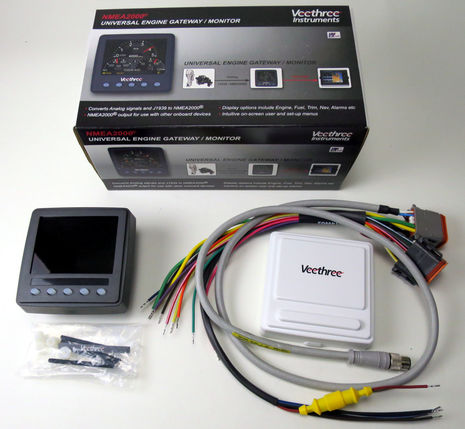 Veethree is a serious instrumentation company with significant engineering and manufacturing facilities in Florida and India (impressive corporate video here). The vast majority of their business is OEM, so while the ruggedly-built Engine Gateway Monitor (EGM) above is packaged as a retail product, you’re not apt to see one at a marine store and it’s even hard to find at Veethree (go to the bottom of this marine page). But my testing suggests that it could be useful on many boats, especially with a few of the firmware features coming to its big brother, the 800 EGM…
Veethree is a serious instrumentation company with significant engineering and manufacturing facilities in Florida and India (impressive corporate video here). The vast majority of their business is OEM, so while the ruggedly-built Engine Gateway Monitor (EGM) above is packaged as a retail product, you’re not apt to see one at a marine store and it’s even hard to find at Veethree (go to the bottom of this marine page). But my testing suggests that it could be useful on many boats, especially with a few of the firmware features coming to its big brother, the 800 EGM…
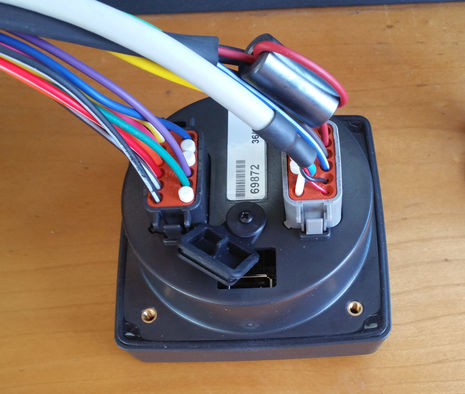 The Veethree EGM seems tougher and more waterproof than competitive gateways that similarly translate analog sensor data to NMEA 2000, like the Actisense EMU-1 I’ve long used or the AlbaCombi I’ve also been testing recently. The backside, for instance, shows a capped USB port and the two gasketed and snap-in Deutsch connectors that help the EGM earn an IP67 rating. The wire harnesses do necessitate multiple butt connections but they should end up fairly strong and waterproof if done right, and it would be easy to replace an EGM if it were ever necessary.
The Veethree EGM seems tougher and more waterproof than competitive gateways that similarly translate analog sensor data to NMEA 2000, like the Actisense EMU-1 I’ve long used or the AlbaCombi I’ve also been testing recently. The backside, for instance, shows a capped USB port and the two gasketed and snap-in Deutsch connectors that help the EGM earn an IP67 rating. The wire harnesses do necessitate multiple butt connections but they should end up fairly strong and waterproof if done right, and it would be easy to replace an EGM if it were ever necessary.
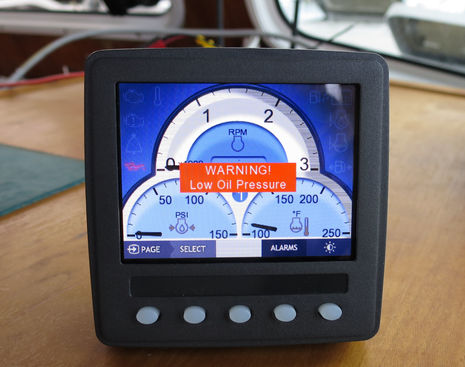 Of course, the EGM is a monitor as well as a gateway with a 3.5-inch sunlight-readable 320 x 240 pixel gauge display that can dim down and/or be put in night colors. The interface can also be used to configure the EGM, and that includes specifying the source of each data type the display supports, whether it’s coming from an anlog sensor, the N2K network, or even the J1939 CANbus input that’s part of the wiring harness. In fact, as first tested and seen on several of these screens, the EGM was nicely showing engine data being generated by Gizmo’s EMU-1 (as well as other N2K data), and if I had a more modern diesel with J1939 output, I trust that the EGM would be able to display at least the more common data types, as well as gateway them to my other N2K screens (like the Maretron J2K100 does).
Of course, the EGM is a monitor as well as a gateway with a 3.5-inch sunlight-readable 320 x 240 pixel gauge display that can dim down and/or be put in night colors. The interface can also be used to configure the EGM, and that includes specifying the source of each data type the display supports, whether it’s coming from an anlog sensor, the N2K network, or even the J1939 CANbus input that’s part of the wiring harness. In fact, as first tested and seen on several of these screens, the EGM was nicely showing engine data being generated by Gizmo’s EMU-1 (as well as other N2K data), and if I had a more modern diesel with J1939 output, I trust that the EGM would be able to display at least the more common data types, as well as gateway them to my other N2K screens (like the Maretron J2K100 does).
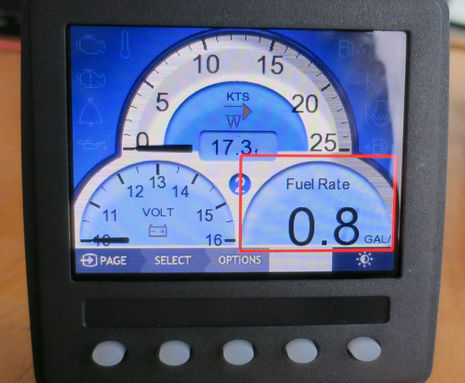 The EGM offers three gauge screens, all the same design except that you can easily make each one unique by stepping through the three “dials” and the numeric window selecting whatever data type you want from the available sources. So in the screen above I’ve “Selected” the lower right dial and am using the “Option” button to choose between Fuel Rate, Oil Pressure, etc. By the way, if you click one of these screen images bigger, you’ll see the many “trouble light” alarm icons that can often be triggered by J1939 or N2K engine streams (but usually aren’t sensored on analog engines).
The EGM offers three gauge screens, all the same design except that you can easily make each one unique by stepping through the three “dials” and the numeric window selecting whatever data type you want from the available sources. So in the screen above I’ve “Selected” the lower right dial and am using the “Option” button to choose between Fuel Rate, Oil Pressure, etc. By the way, if you click one of these screen images bigger, you’ll see the many “trouble light” alarm icons that can often be triggered by J1939 or N2K engine streams (but usually aren’t sensored on analog engines).
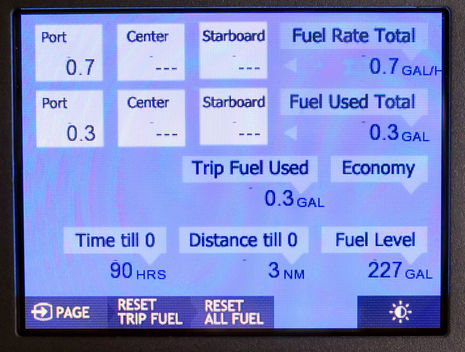 Finally, there’s a fourth screen that can display the fuel burn of up to three engines with flow totals and MPG calculated by the EGM and fuel level based on one tank level sensor. (Remember, if you have fuel flow, you may have two ways to tell how much is left.) There’s a lot going on under the EGM’s hood, though in fact it’s only a version of what Veethree makes available to OEM engineers as the Veecan 320 customizable display (via master distributor New Eagle). I believe we’ve seen the underlying 320 elsewhere in marine electronics, like this Offshore Systems tank monitor, but if you want the EGM model, the best source seems to be a dealer with a Gemeco account (and expect a retail price of about $700).
Finally, there’s a fourth screen that can display the fuel burn of up to three engines with flow totals and MPG calculated by the EGM and fuel level based on one tank level sensor. (Remember, if you have fuel flow, you may have two ways to tell how much is left.) There’s a lot going on under the EGM’s hood, though in fact it’s only a version of what Veethree makes available to OEM engineers as the Veecan 320 customizable display (via master distributor New Eagle). I believe we’ve seen the underlying 320 elsewhere in marine electronics, like this Offshore Systems tank monitor, but if you want the EGM model, the best source seems to be a dealer with a Gemeco account (and expect a retail price of about $700).
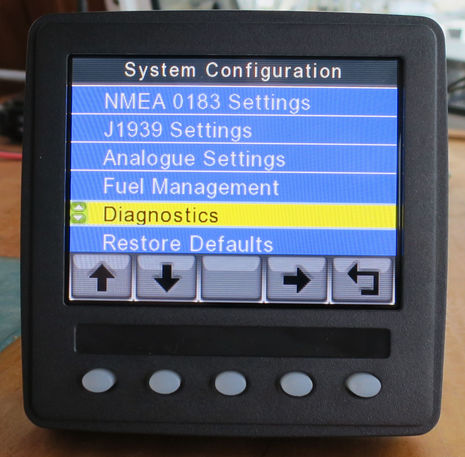 Given all the Veethree engineering behind the EGM, it’s not surprising to find extensive configuration and diagnostics. And it’s easy to use with the five-button soft key interface, plus a decent manual (download here). A true geek, for instance, can see and log the raw data coming into either CAN port, check out the NMEA 0183 port (I hadn’t mentioned yet), or monitor the raw analog inputs alongside their calibrated output.
Given all the Veethree engineering behind the EGM, it’s not surprising to find extensive configuration and diagnostics. And it’s easy to use with the five-button soft key interface, plus a decent manual (download here). A true geek, for instance, can see and log the raw data coming into either CAN port, check out the NMEA 0183 port (I hadn’t mentioned yet), or monitor the raw analog inputs alongside their calibrated output.
 I was pleased just to get the whole list of possible data types, sources, and live values. In this case I was still using the EMU-1 engine data already on Gizmo’s N2K network, but then I detached that gateway and temporarily connected three of the resistance-based sensors — coolant temp plus oil and boost pressure — to the corresponding EGM inputs.
I was pleased just to get the whole list of possible data types, sources, and live values. In this case I was still using the EMU-1 engine data already on Gizmo’s N2K network, but then I detached that gateway and temporarily connected three of the resistance-based sensors — coolant temp plus oil and boost pressure — to the corresponding EGM inputs.
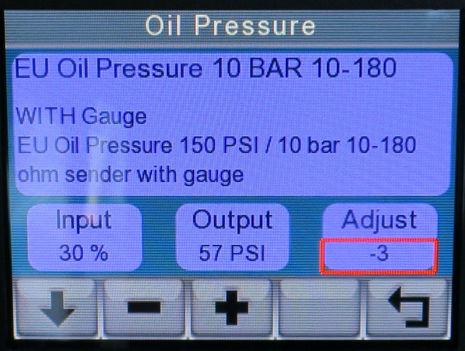 I was again impressed with the calibration routine, which starts by picking one of several curves that mimic traditional gauges. This is similar to the Actisense configuration, though the EMU-1 automatically determines whether the gauge is still in use, which is to say whether or not to provide signal current to the sensor. On the other hand, the EMU-1 does not offer further adjustment (though that’s promised in a future update). I have not yet been underway with the EGM enough to really see how close I’ve calibrated it to Gizmo’s remaining analog gauges — better yet would be independent sensors like a flywheel RPM counter — but it looks pretty good (and actually it only takes consistently inaccurate results to monitor and alarm an engine pretty well).
I was again impressed with the calibration routine, which starts by picking one of several curves that mimic traditional gauges. This is similar to the Actisense configuration, though the EMU-1 automatically determines whether the gauge is still in use, which is to say whether or not to provide signal current to the sensor. On the other hand, the EMU-1 does not offer further adjustment (though that’s promised in a future update). I have not yet been underway with the EGM enough to really see how close I’ve calibrated it to Gizmo’s remaining analog gauges — better yet would be independent sensors like a flywheel RPM counter — but it looks pretty good (and actually it only takes consistently inaccurate results to monitor and alarm an engine pretty well).
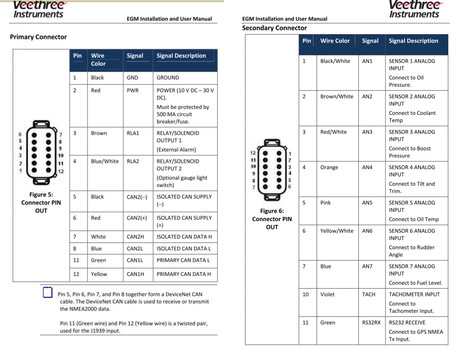 However, the Veethree EGM has two significant limitations. If you look closely at the Deutsch connector diagrams above, you’ll see that it has 7 analog resistance-based inputs, but they are set up for specific sensors. In Gizmo’s case, I can monitor and gateway 3 important engine values but not transmission oil pressure (like I can on the EMU-1). Plus, I can only monitor one of the boat’s two fuel tanks, and 3 of the EGM’s inputs would go unused when they could be wired to other tank senders and/or temp sensors on, say, Gizmo’s shaft log and raw water pump. Veethree certainly has the chops to make these inputs more flexible, but that would also make the interface more complex and might add to the technical support burden. But then again, Sales Engineer Eric Mueller — who I met at the Miami Show — emphasized that Veethree does respond to customer input.
However, the Veethree EGM has two significant limitations. If you look closely at the Deutsch connector diagrams above, you’ll see that it has 7 analog resistance-based inputs, but they are set up for specific sensors. In Gizmo’s case, I can monitor and gateway 3 important engine values but not transmission oil pressure (like I can on the EMU-1). Plus, I can only monitor one of the boat’s two fuel tanks, and 3 of the EGM’s inputs would go unused when they could be wired to other tank senders and/or temp sensors on, say, Gizmo’s shaft log and raw water pump. Veethree certainly has the chops to make these inputs more flexible, but that would also make the interface more complex and might add to the technical support burden. But then again, Sales Engineer Eric Mueller — who I met at the Miami Show — emphasized that Veethree does respond to customer input.
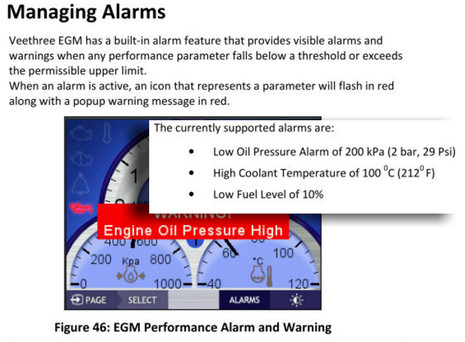 The EGM also lacks the voltage-based analog inputs needed to display and gateway the simple on/off engine alarm sensors found on engines like my Volvo Penta, but Veethree has worked around this in an interesting way. As explained in the manual, the alarms are programmed into the EGM using the regular sensor values instead of the alarm sensor. This is not ideal in my book — I like redundancy — but it seems to work fine and suggests that the EGM could be tweaked so that users could set their own custom alarm points below the extreme values typical of simple on/off alarms (as I strongly favor).
The EGM also lacks the voltage-based analog inputs needed to display and gateway the simple on/off engine alarm sensors found on engines like my Volvo Penta, but Veethree has worked around this in an interesting way. As explained in the manual, the alarms are programmed into the EGM using the regular sensor values instead of the alarm sensor. This is not ideal in my book — I like redundancy — but it seems to work fine and suggests that the EGM could be tweaked so that users could set their own custom alarm points below the extreme values typical of simple on/off alarms (as I strongly favor).
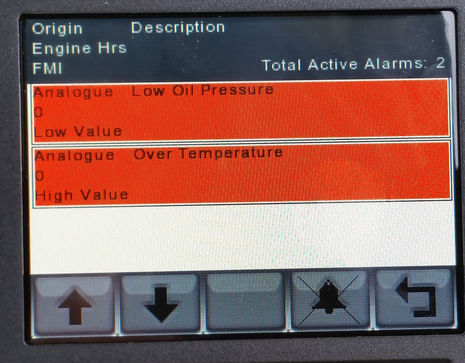 In fact, after hearing my input on this subject, Mueller wrote, “…both the high and low settings for those [programmed alarms] as well as additional alarms for all of the predefined analog inputs of the EGM can be modified via the configuration INI text file. For an advanced user who would like to do so, we could provide the text file along with a script that would be both placed on a USB stick and used to upload to the unit.” Nice! That means you could have early warning alarms showing up on the EGM, which would be even more useful if the EGM gets more flexible inputs (sorry, Eric).
In fact, after hearing my input on this subject, Mueller wrote, “…both the high and low settings for those [programmed alarms] as well as additional alarms for all of the predefined analog inputs of the EGM can be modified via the configuration INI text file. For an advanced user who would like to do so, we could provide the text file along with a script that would be both placed on a USB stick and used to upload to the unit.” Nice! That means you could have early warning alarms showing up on the EGM, which would be even more useful if the EGM gets more flexible inputs (sorry, Eric).
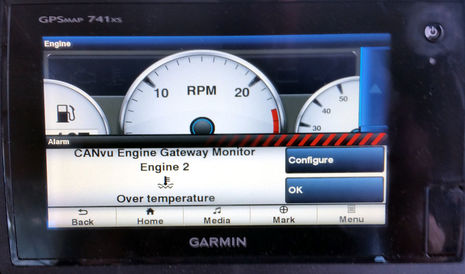 And here’s evidence that the EGM does a good job distributing alarms over NMEA 2000 (if the display knows what to do with the PGN). As discussed recently, the EMU-1 does have inputs for on/off alarm sensors and the output triggers a similar pop-up, but the only way I can program and display custom early warning engine and related alarms is within Gizmo’s Maretron system. Obviously, I’d like this situation to change — sorry for such a long entry — and it can easily; all the pieces are available.
And here’s evidence that the EGM does a good job distributing alarms over NMEA 2000 (if the display knows what to do with the PGN). As discussed recently, the EMU-1 does have inputs for on/off alarm sensors and the output triggers a similar pop-up, but the only way I can program and display custom early warning engine and related alarms is within Gizmo’s Maretron system. Obviously, I’d like this situation to change — sorry for such a long entry — and it can easily; all the pieces are available.
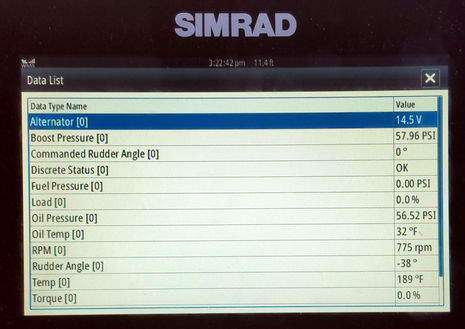 At any rate, much of the info seen on this Simrad NSS evo2 utility screen is coming from old analog sensors via the EGM (some is demo, as shown on the EGM Data Viewer screen further up). Most interesting for me is the Boost Pressure value, as neither my analog gauge nor the EMU-1 show any. I had presumed a broken sensor, and maybe what’s shown above is just aggressive calibration of a very weak signal. Only a high speed test will tell the story, and I’ll report back in the comments section, but then again, Veethree has a lot of experience with analog sensors.
At any rate, much of the info seen on this Simrad NSS evo2 utility screen is coming from old analog sensors via the EGM (some is demo, as shown on the EGM Data Viewer screen further up). Most interesting for me is the Boost Pressure value, as neither my analog gauge nor the EMU-1 show any. I had presumed a broken sensor, and maybe what’s shown above is just aggressive calibration of a very weak signal. Only a high speed test will tell the story, and I’ll report back in the comments section, but then again, Veethree has a lot of experience with analog sensors.
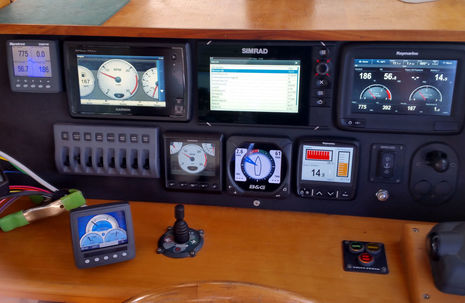 So here’s the EGM displaying and gatewaying my analog engine sensing to all sorts of N2K displays at Gizmo’s lower helm. But I’m not done yet, as Mueller also sent me a simulation of what the bigger EGM 800 will look like when released, and wow, couldn’t it do a lot of good work on many boats? Before I go on, though, note that the original EGM also has two relay outputs so it can drive at least an audible alarm system.
So here’s the EGM displaying and gatewaying my analog engine sensing to all sorts of N2K displays at Gizmo’s lower helm. But I’m not done yet, as Mueller also sent me a simulation of what the bigger EGM 800 will look like when released, and wow, couldn’t it do a lot of good work on many boats? Before I go on, though, note that the original EGM also has two relay outputs so it can drive at least an audible alarm system.
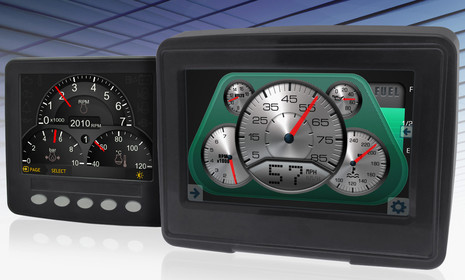 The Veethree EGM 800 will be based on the VeeCan 800 OEM product, like the EGM is based on the VeeCan 320, and hence the screen is 800 x 400 pixels. If you download the VeeCan 800 datasheet, you’ll learn that this gadget is also touch screen and has three 12-way Deutsch connectors on the back. So, in addition to NMEA 2000, J1939, RS232 (0183), tachometer and Ethernet ports, the EGM 800 will have 14 analog inputs, 3 digital/flow sensor inputs, and 8 switched outputs now called Relay/Solenoid because it can conceivably go beyond display and gateway duties to controlling other devices.
The Veethree EGM 800 will be based on the VeeCan 800 OEM product, like the EGM is based on the VeeCan 320, and hence the screen is 800 x 400 pixels. If you download the VeeCan 800 datasheet, you’ll learn that this gadget is also touch screen and has three 12-way Deutsch connectors on the back. So, in addition to NMEA 2000, J1939, RS232 (0183), tachometer and Ethernet ports, the EGM 800 will have 14 analog inputs, 3 digital/flow sensor inputs, and 8 switched outputs now called Relay/Solenoid because it can conceivably go beyond display and gateway duties to controlling other devices.
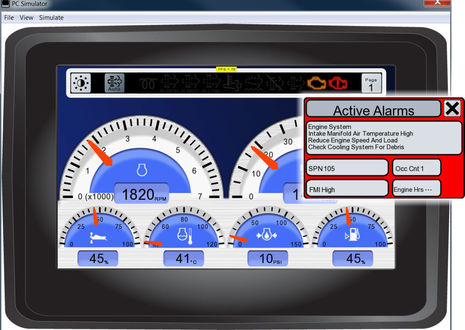 As best I can tell from the beta firmware simulation, the EGM 800 may only have one display screen, but it can show a lot. And I’m told that one design goal is the ability to show every possible J1939 engine value, including new Tier 4 data. What I can see in the simulation is how Veethree is making the EGM 800 much more flexible than the orginal.
As best I can tell from the beta firmware simulation, the EGM 800 may only have one display screen, but it can show a lot. And I’m told that one design goal is the ability to show every possible J1939 engine value, including new Tier 4 data. What I can see in the simulation is how Veethree is making the EGM 800 much more flexible than the orginal.
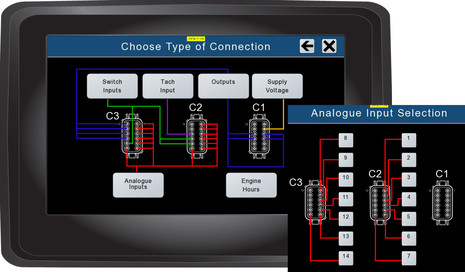 For instance, when you go to the nifty graphic analog input setup screen, your touch pick can apparently handle any resistive sensor you want. On Gizmo that might be the four main engine sensors, the four tank sensors (currently on a CZone Signal Interface), the four active temp sensors on a Maretron TMP100, and I’d still have 2 free inputs. Given that and the fact that no N2K-to-PC gateway is needed for setup and calibration, the EGM 800’s anticipated $1,400-1,500 suggested retail doesn’t seem so high.
For instance, when you go to the nifty graphic analog input setup screen, your touch pick can apparently handle any resistive sensor you want. On Gizmo that might be the four main engine sensors, the four tank sensors (currently on a CZone Signal Interface), the four active temp sensors on a Maretron TMP100, and I’d still have 2 free inputs. Given that and the fact that no N2K-to-PC gateway is needed for setup and calibration, the EGM 800’s anticipated $1,400-1,500 suggested retail doesn’t seem so high.
 Calibration also seems improved or at least prettier, and the Title and Line fields suggest the ability to custom name the inputs and perhaps keep notes on their installation, both similar to what Maretron N2KAnalyzer can do. Now wouldn’t it be nice if Veethree, Maretron, and the MFD/N2K instrument manufacturers all adopted the Label function supposedly built into N2K so something somewhat exotic like “Starboard GenSet Raw Water Pump Temp” traveled around the network like the value can?
Calibration also seems improved or at least prettier, and the Title and Line fields suggest the ability to custom name the inputs and perhaps keep notes on their installation, both similar to what Maretron N2KAnalyzer can do. Now wouldn’t it be nice if Veethree, Maretron, and the MFD/N2K instrument manufacturers all adopted the Label function supposedly built into N2K so something somewhat exotic like “Starboard GenSet Raw Water Pump Temp” traveled around the network like the value can?
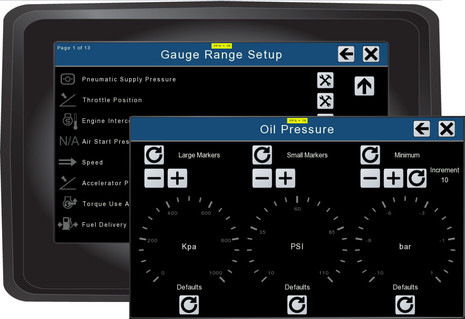 But I saved the best for last. The EGM 800 offers excellent gauge building, almost as flexible and complete as Maretron’s but a lot easier than what it takes on a Maretron DSM (though N2KView is likely also much easier). Note from the screenshot how you can not only change the range, but also the large and small markers and even the increment of change. Moreover, every single value in the EGM 800’s database, regardless of source, can be alarmed high and/or low with a choice of alarm severity, as seen below. That’s what I’m talking about!
But I saved the best for last. The EGM 800 offers excellent gauge building, almost as flexible and complete as Maretron’s but a lot easier than what it takes on a Maretron DSM (though N2KView is likely also much easier). Note from the screenshot how you can not only change the range, but also the large and small markers and even the increment of change. Moreover, every single value in the EGM 800’s database, regardless of source, can be alarmed high and/or low with a choice of alarm severity, as seen below. That’s what I’m talking about!
Actually, Maretron is still ahead in sophisticated alarming — like a Hatch Open alert conditional to SOG over 1 knot — but Veethree’s EGM series puts some really valuable possibilities into rugged, self-contained devices suitable to small and medium size boats. And while I’m not sure many do-it-yourselfers are up to this sort of install, despite Veethree’s quality manual and interface, it’s good to know what your trusty professional has available. There also may be developers in other marine niches who might like to partner with Veethree (I know one that already has), and let’s hope that the big MFD programmers take a good gander at how well gauge customization and alarming can be done on a touch screen.


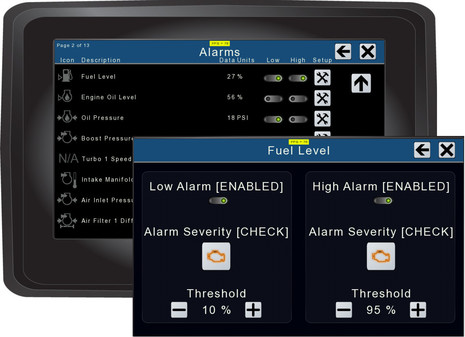











Those displays end up everywhere!
Does this gateway provide the engine sensor failure faults broadcasted over J1939 on NMEA2000 network?
Yes the J1939 DM1 faults are mapped to NMEA 2000 engine alarms.
VDO has its own NMEA 2000 OceanLink gateway now, sort of like the VeeThree, and it looks powerful:
http://www.vdo.com/marine-solutions/oceanlink/tft-display/
Plus Yacht Devices now has a gateway for older Volvo Penta engines (like mine ;-)…
http://www.yachtd.com/products/j1708_gateway.html